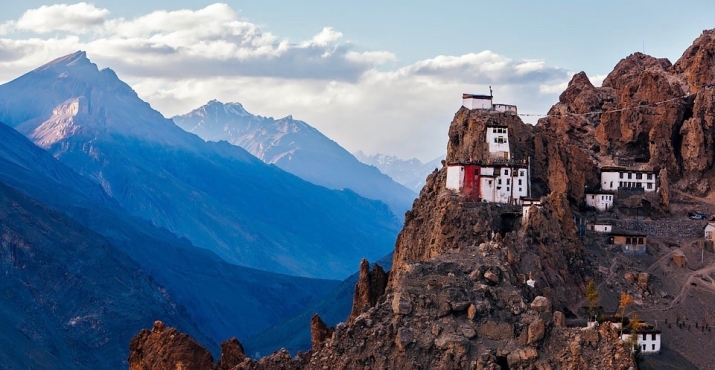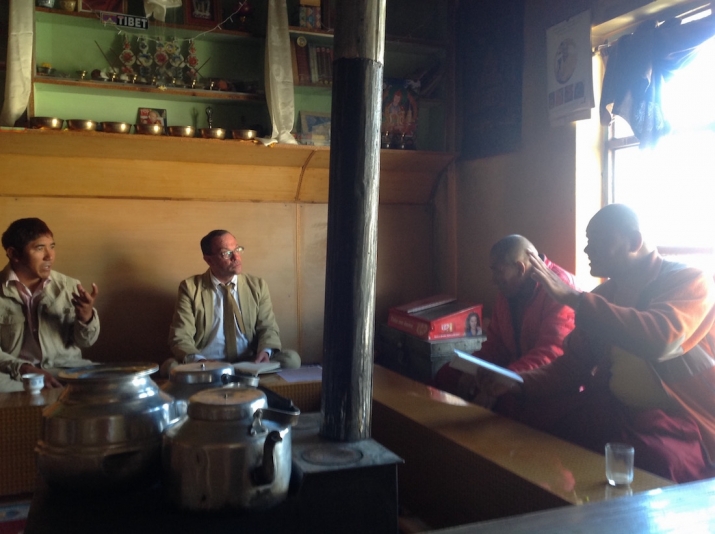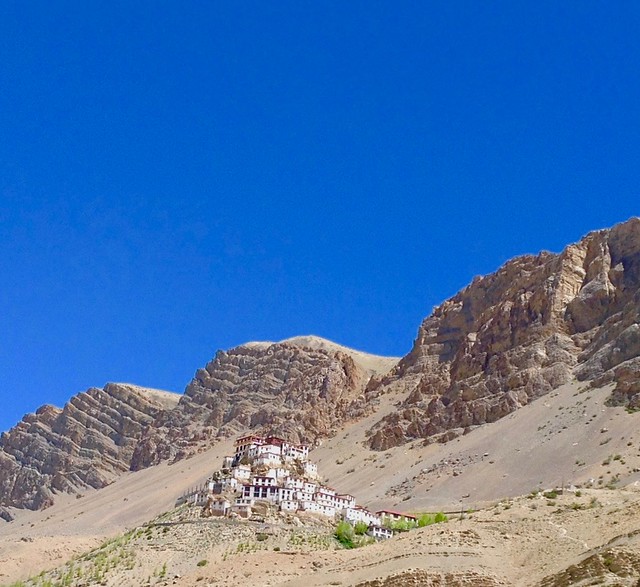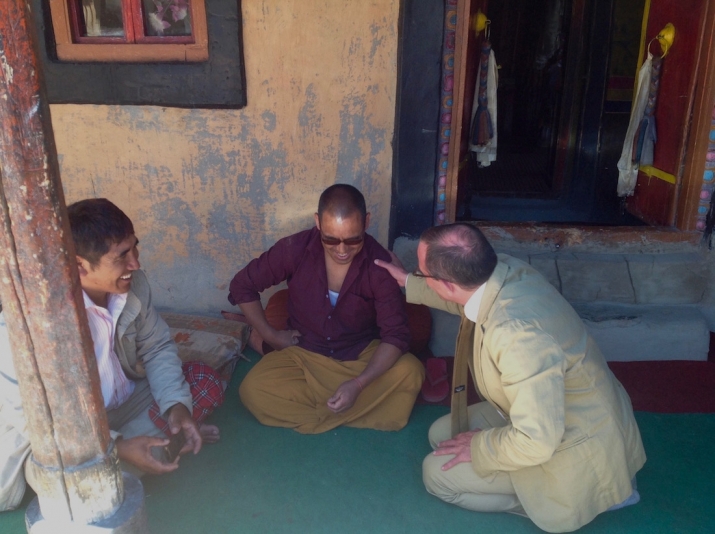FEATURES|COLUMNS|Ancient Dances
Finding Excellence, Part 4: What Buddhists Do
 The 1,000-year-old Dhankar Gompa in Spiti Valley, Himachal Pradesh, home to the most rigorous meditation requirements for Cham dancing that we have encountered. Photo copyright Himanshu Khagta, 2013.
The 1,000-year-old Dhankar Gompa in Spiti Valley, Himachal Pradesh, home to the most rigorous meditation requirements for Cham dancing that we have encountered. Photo copyright Himanshu Khagta, 2013.Mutual amazement at what the other does not find extraordinary is a situation I regularly encounter when speaking with monk dancers. They usually cannot believe that someone like me exists—who cares only about the quality and transmission of ancient gnostic dance. And I am routinely astounded by some of the training certain monasteries require of their Cham dancers.
In the summer of 2016, we distributed a rare Buddhist dance treatise, The Snow Lion’s Attributes, published by Core of Culture, the organization I direct, to monasteries in Himachal Pradesh, northern India, where ancient roots and relative isolation from destructive modernity have maintained for the world some of the most serious and undiluted practices of Vajrayana Buddhism, respected worldwide for its profound teachings in meditation yoga. Actor Richard Gere, who does meditation retreats in remote Zanskar, refers to Vajrayana monks as “the Olympians of meditation.”

The Snow Lion’s Attrubutes, a Buddhist dance treatise
published by Core of Culture and distributed to
monasteries in Himachal Pradesh. From Core of
Culture. 2015.
Perhaps you will agree with me that the meditation requirements aligned with Buddhist Cham dance at the 1,000-year-old monasteries at Dhankar and nearby Kye are astonishing. My astonishment is based on nearly 20 years of research, documenting Cham throughout the Himalaya—particularly in Bhutan, where Cham practice is exuberant and skillful. It is refreshing after 20 years to still be so amazed and enchanted by the subject of my driving interest.
There are dates, monastic roles and hierarchies, and changing schools of Buddhism that need unwinding to tell this story. Dhankar and Kye monasteries were built during the Guge Kingdom in the 11th century, part of an expansionist plan to extend the empire with trade, art, and religion. Dhankar and Kye marked architectural departures as they were developed into fortresses as well as monasteries, and so were perched on high cliffs, raised up strategically, in a way we associate with many monasteries now.
 Senior monks Tupten Sherab, 60, and Tupten Gyaltsen, 50, explain the interpenetration of meditation and dance at Dhankar Gompa to Core of Culture director Joseph Houseal and field associate Dechen Lundup. Photo by Konchok Rinchen for Core of Culture, 2016
Senior monks Tupten Sherab, 60, and Tupten Gyaltsen, 50, explain the interpenetration of meditation and dance at Dhankar Gompa to Core of Culture director Joseph Houseal and field associate Dechen Lundup. Photo by Konchok Rinchen for Core of Culture, 2016UNESCO has placed Dhankar Gompa on the Watch List of Endangered World Monuments. Both the mountain cliff and the ancient tower perched upon it are precariously holding on. Kye Gompa is nested on a mountain spur among mountains, a most dramatic setting. The Gelugpa subjugation of these monasteries was coupled with new architecture, purpose, and rituals. Both monasteries have endured attacks and invasions.
Dhankar was a hereditary and military monastery, aligning itself and its rituals with several Buddhist schools. Kye was a trading post and a center of debate. The Gelugpa school, notable for being the school of the Dalai Lama, was not established until the 15th century. The monasteries in this account had half a millennium of rituals and dance before the Gelugpa asserted political authority and fortified the existing structures. Dhankar and Kye both became known for the seriousness of their meditation practice, just as Tabo Gompa in Spiti Valley was renowned for its scholarship and accomplished monks.
Here’s the time warp: Dhankar does the same Cham as ancient Tabo, which means it derives from a Gelugpa monk named Jampa Tharchen, who escaped from Tibet in 1957 and found refuge at Tabo. The lineage he taught belongs to Tashigang Gompa in Gnari, Tibet. Seemingly—and this needs to be clarified by further research—replacing the dances already performed there, ostensibly by offering a more authoritative and complete canon of Gelugpa Cham dances direct from Tibet.
In 1985, the Panchen Choegyal Nyima, from the legendary Tashilunpo Monastery founded by the first Dalai Lama in the 15th century, brought their lineage of Cham dances into India. A monk named Karchen Laktor taught these dances to Kye Gompa in Spiti, to Thikse and Spituk monasteries in Ladakh, and to a monastery in Nubra Valley.

Lama Tipa Sherab Zangpo of Kye Gompa receiving a copy of The Snow Lion’s Attributes from Core of
Culture director Joseph Houseal and field associate Dechen Lundup. Photo by Konchok Rinchen for
Core of Culture, 2016
In both cases, a fresh input of authoritative Cham, directly transmitted from Tibet, was integrated with local meditation practices hundreds of years old. This explains to a degree why the meditation requirements to perform Cham are so thorough at these monasteries. Although a young monk who could not contain himself during our meeting with senior monks blurted out the obvious standard that should not be overlooked: “Where the Dharma is strong, Cham is strong!”
The names of monastery roles and positions are not universal. The same title at one monastery can imply a different job at another. However, three positions are at play in this exposition of Cham and meditation. The omze is the master of rituals and chant—meaning he leads the accompaniment of Cham dances and has memorized all the ancient sutras, scriptures, and mantras that are chanted. This is encyclopedic memorization.
The lama tipa is an archaic title for a regent, someone who rules in the name of someone else. He is not the abbot, but has all the authority and is also required to know how to run and manage every aspect of a monastery. The champon is the dance master, required to know every dance and to be able to teach it. At Dhankar and Kye, this implies knowing the tantric visualization and Deity Action Yoga empowering the Cham dances.
Prepare to be astonished. At Dhankar Gompa, the omze must undertake a two-year cave retreat practicing his primary teachings before he can become the lama tipa, a position he fills for two years. He must then do a further one-year cave retreat specializing in Yiddam meditation in order to become the champon.
Primary teachings here refer to the teachings given to you by your own guru, and as such are entirely personal and designed by the guru for each person he teaches. No two are the same. It is a kind of development of the tantric personality of an individual. A Yiddam is a meditation deity, and in the case of a rising champon, the monk must accomplish the yogic act of conjuring the deity Mahakala, and further, making him move. The lama tipa at Dankhar explained that Mahakala is the root of all Deity Action yoga for Cham and any deity can be yogically extrapolated having mastered making a Mahakala visualization move.
This is really the line between black and white magic as once a new being has been realized, the meditator, or sorcerer as the case may be, has the choice to make the being do anything, and it is at this point that tantric adepts can lose control over their own creations, just as Mickey Mouse did in The Sorcerer’s Apprentice. This is serious, ancient yoga: older than Buddhism, older than the hills, and one reason Vajrayana Buddhism is so special for keeping these skills alive. This is the fine, much debated, tantric line between something actually happening and something symbolically happening.

Stunning, remote, isolated, the 1,000 year-old Kye Gompa in Spiti Valley, a fortress and sanctuary of
serious dance practice. Photo by Konchok Rinchen for Core of Culture, 2016
At Kye Gompa, no meditation requirement exists for the position of omze, but he must complete one year of Yiddam meditation before becoming the champon and teaching the other dancers. The champon can keep the position indefinitely providing he completes a one-week Yiddam meditation retreat each year before teaching Cham.
Dhankar Gompa has the most intensive meditation retreat requirement for the position of champon of any monastery I have encountered in 17 years. Kye Gompa also clearly prioritizes the mastery of meditation as a pre-requisite for teaching Cham to anyone else. Clearly these profound approaches to cultivating the inner person for a dance performance have nothing to do with theatricality or a public audience. In fact these aspects seem mundane, irrelevant to our discussion.
The lama tipa at Dhankar was busily sweeping the 1,000-year-old tower where the special chambers of the Dalai Lama are situated when I accidentally met him after talking to two senior monks. I was thrilled to encounter him as he was about to embark on a year-long cave retreat to gain the yogic skill of conjuring Mahakala and making him move, and then becoming the champon. Perhaps too thrilled; he thought my excitement was unwarranted.
 Lama Tipa Tshering Tobden of Dhankar Gompa sharing a laugh with Core of Culture director Joseph Houseal and field associate Dechen Lundup outside the Dalai Lama’s chambers. He was amused that we thought his extreme meditation requirements were exceptional. Photo by Konchok Rinchen for Core of Culture, 2016
Lama Tipa Tshering Tobden of Dhankar Gompa sharing a laugh with Core of Culture director Joseph Houseal and field associate Dechen Lundup outside the Dalai Lama’s chambers. He was amused that we thought his extreme meditation requirements were exceptional. Photo by Konchok Rinchen for Core of Culture, 2016He told me with some amusement that yogic mastery was not an amazing feat, nor peculiar to him, nor intimidating, but rather an aspect of ancient mental training protected by Buddhism since its inception, when Guru Rinpoche subjugated and at the same time protected the ancient pre-Buddhist spiritual beings and the deep psychic and intellectual forces they embody and represent.
“You’ve been visiting the most remote monasteries of all sects, with a dance treatise, wearing a mustard-colored suit and tie, and you think we are out of the ordinary?” he enquired with humor. “Deity Yoga for Cham? It’s a known thing,” he continued. “What Buddhists do.”
See more
Finding Excellence, Part 1: Of Course They Don’t Talk About It (Buddhistdoor Global)
Finding Excellence, Part 2: A Tradition of Transmission (Buddhistdoor Global)
Finding Excellence, Part 3: Who is the Best Dancer Here? (Buddhistdoor Global)
Finding Excellence, Part 5: A Buddhist Land (Buddhistdoor Global)














